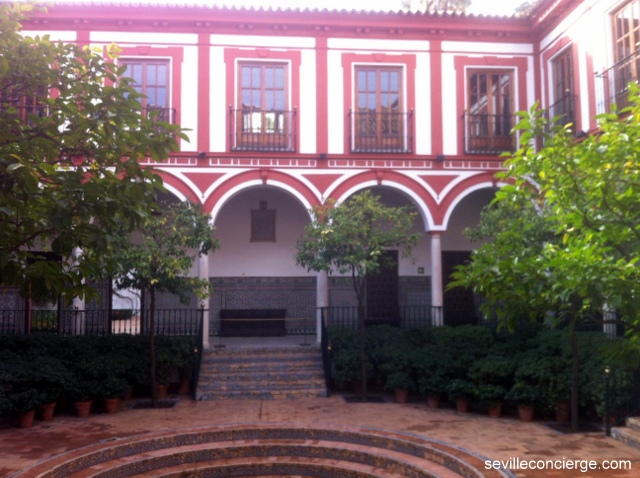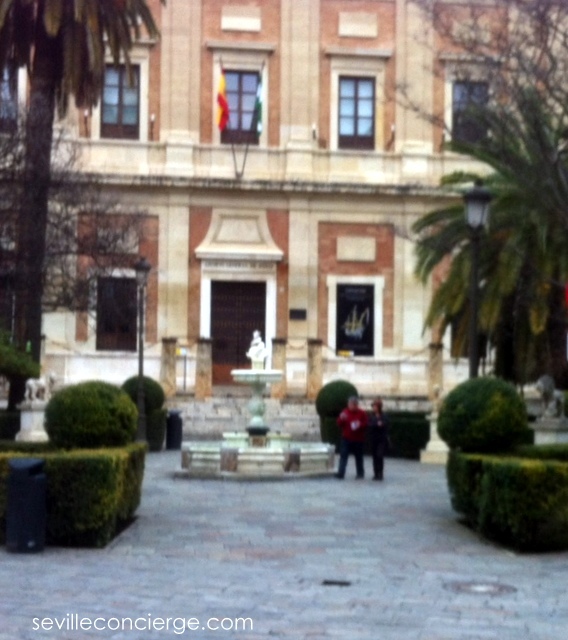The Reales Alcazares, or Royal Palaces, of Seville is the oldest working palace complex in Europe (that is, it’s still an official royal residence, though actually infrequently with the royals in residence), and one of the most important heritage monuments in Spain. Not surprisingly, then, it’s at the top of many people’s “Things to see in Seville” list, especially since it became the locale for the filming of the Water Gardens of Dorne sequences in the hugely popular Game of Thrones TV series.

Entrance to the Mudejar Palace
In the present day there are two palaces, the more famous Mudejar Palace built by Pedro I, “The Cruel”, in the 14th century, and the Gothic Palace originally built by Alfonso X, “The Wise”, at the end of the 13th century, but substantially rebuilt following damage caused by the Great Lisbon Earthquake of 1755. Behind these are the gardens, with both small formal gardens close to the palaces, and larger gardens in both formal and informal styles beyond them.
The first palace on the site was built in 913 by the city governor for the Córdoba caliphate. The palace is long gone, but the walls of the enclosure are still there – they’re the rather forbidding walls you see in the Plaza del Triunfo and Plaza de la Alianza. In the later Moorish periods there was a positive frenzy of building and rebuilding, of which little now remains except the Patio de Yeso. Most of the palaces were levelled to create the space for the Christian period palaces.

Patio de la Montería
Entrance to the complex is from the Plaza del Triunfo through the Lion gate, an outer courtyard, and a section of old Moorish wall, into the Patio de Montería, the spacious paved courtyard in front of the Mudejar Palace. The name (literally the courtyard of mounting) comes from the fact that this is where the court would assemble to go hunting.
The building to the right, with the windowed gallery on the first floor, was originally part of the Casa de la Contratación, founded in 1503 to control all aspects of the trade with the Indies, and includes the Hall of the Admiral and the Audience Hall, which are hung with paintings and tapestries, and a room with an internationally important collection of fans.

Courtyard Garden
In the corner of the courtyard between this and the palace are the stairs that lead up to the modern day Royal Apartments, where the Audience Chamber and Pedro I’s bedroom are the highlights. Entrance for the guided tours is extra, and because of the limited capacity you should try to book ahead.
The main attraction, though, is undoubtedly the Mudejar Palace of Pedro I, built in the 1360s, and considered one of the best examples of late Moorish architecture in Spain (although commissioned in the Christian period, many of the craftsmen and artists who created its spectacular tiles and intricate ceilings were Moorish “Mudejars”, either those who remained in Seville after its conquest by Ferdinand III, but some provided by the Muslim Emir of Granada).

Patio de las Doncellas
If you turn left at the entrance a passageway brings you almost at once to the central courtyard, the Patio de las Doncellas or Courtyard of the Maidens, named for the legend that the former Moorish rulers had exacted a tribute of Christian maidens for their harems. A long rectangular pool is flanked by sunken gardens (part of the original layout only revealed relatively recently after several centuries concealed beneath a later marble floor) and covered colonnades of pillars and arches to provide shade from the summer sun. It would be easy to rest here for a while in the peace and quiet (when it’s not too busy!), but we must pass on to the far end of the courtyard and the spectacular Hall of Ambassadors, once Pedro’s throne room, with its domed ceiling representing the universe and the stars.

Mezzanine and upper Gallery, Patio of the Dolls
Around these public areas of the palace are arranged the royal quarters, including the Patio of the Dolls (the mezzanine and upper gallery were added in the 19th century for Isabela II, and include decorations brought from the Alhambra), and the Prince’s Room. The rooms facing the gardens have windows partly masked by vegetation, and are often bathed in an almost surreal greenish glow.
From the corner of the Patio de las Doncellas a stairway leads up to the halls of Carlos V, which are actually the remodelled upper rooms of the old Gothic Palace. Here you can find a number of magnificent tapestries of historical scenes, and windows overlooking the gardens which will be instantly recognisable to all Game of Thrones fans. The Patio de las Cruces was once the upper part of the courtyard of one of the Moorish palaces, but the ground floor was later filled in. The original was planted with orange trees whose fruit could be plucked from the galleries of the upper level.

Baths of Doña Maria de Padilla
Behind the palaces are the gardens. Closest to the palace are the smaller formal gardens with fountains and pools. From one of these a passage under the Gothic palace takes you to the Baths of Doña Maria de Padilla (used to store rainwater for the gardens), which are one of my favourite places in the entire complex. The vaulted ceilings, muted sounds and filtered light create a unique, almost other-worldly atmosphere. Nearby is the famous Pool of Mercury, with its water spout coming from the roof of the palace, and its sleek carp swimming in the depths. Alongside is the Gallery of Grotesques, a renaissance period feature created from the wall of one of the earliest Moorish palace enclosures. The gardens on the other side are 19th and 20th century creations, but none the worse for that, and a great view of them, especially the Poets Garden, can be had from the upper walkway of the Grotesques. Other things to watch out for are the Carlos V Pavilion, the Lion Pavilion, and the Maze.
The way out of the Palace is through the apeadero (where visitors would alight from their carriages) to the Patio de las Banderas (the courtyard of the flags, the reception point for ambassadors). Resist the temptation to go straight back to the cathedral and instead turn right and right again into the Calle de la Juderia. It’s the start of a whole new adventure….



 The museum has a great atmosphere, small enough to avoid art fatigue, large enough for a good variety of styles and types of art. For me it particularly managed to encapsulate something of the essence of Seville in its paintings of patios and street scenes, and the decorations and furnishings of a typical upper class house, so that I was constantly reminded of the reasons why I made Seville my home, and the things I love here.
The museum has a great atmosphere, small enough to avoid art fatigue, large enough for a good variety of styles and types of art. For me it particularly managed to encapsulate something of the essence of Seville in its paintings of patios and street scenes, and the decorations and furnishings of a typical upper class house, so that I was constantly reminded of the reasons why I made Seville my home, and the things I love here.




 Still, it was fascinating to see something of the city’s industrial heritage, and to remember that history is not all about Cathedrals, Palaces, and other monuments, and that for a majority of the common people life had more to do with this harsher aspect than it did with the grand lifestyles of the aristocracy and the rich.
Still, it was fascinating to see something of the city’s industrial heritage, and to remember that history is not all about Cathedrals, Palaces, and other monuments, and that for a majority of the common people life had more to do with this harsher aspect than it did with the grand lifestyles of the aristocracy and the rich.


















 Mateos Gago Street
Mateos Gago Street hall, the Casa Consistorial (1527-1564), usually known as the Ayuntamiento, with its ornate plateresque decoration and the arcade that gave access to the Franciscan friary which occupied the whole of what is now Plaza Nueva. In the later years of the century the Real Audencia, a court of the Castilian crown, was built on the other side of the Plaza San Francisco, with the Royal Prison on the corner of Sierpes street (the site is now occupied by a bank). Miguel de Cervantes, who wrote Don Quixote, was for a short time “a guest of His Majesty” here.
hall, the Casa Consistorial (1527-1564), usually known as the Ayuntamiento, with its ornate plateresque decoration and the arcade that gave access to the Franciscan friary which occupied the whole of what is now Plaza Nueva. In the later years of the century the Real Audencia, a court of the Castilian crown, was built on the other side of the Plaza San Francisco, with the Royal Prison on the corner of Sierpes street (the site is now occupied by a bank). Miguel de Cervantes, who wrote Don Quixote, was for a short time “a guest of His Majesty” here.  From the same period are the Archivo General de Indias, built originally as the Casa Lonja or commodities exchange, and now the third of Seville’s World Heritage buildings, the Casa Moneda (Royal Mint), where silver from the New World was minted into coin, and the Hospital de Cinco Llagas (the Five Wounds), which is now the home of the Andalucian Parliament. At the same time many churches, monasteries and convents, as well as private palaces of the aristocracy and merchants all over the city were built or elarged.
From the same period are the Archivo General de Indias, built originally as the Casa Lonja or commodities exchange, and now the third of Seville’s World Heritage buildings, the Casa Moneda (Royal Mint), where silver from the New World was minted into coin, and the Hospital de Cinco Llagas (the Five Wounds), which is now the home of the Andalucian Parliament. At the same time many churches, monasteries and convents, as well as private palaces of the aristocracy and merchants all over the city were built or elarged.




